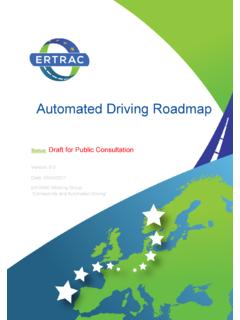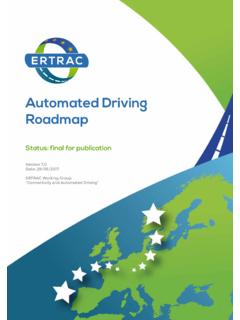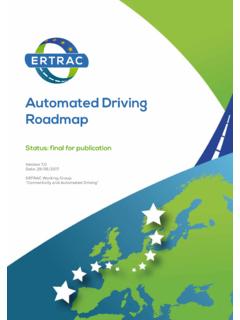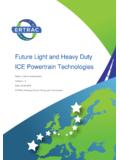Transcription of Automated Driving Roadmap ERTRAC Working Group Date: …
1 Automated Driving RoadmapStatus: Draft for Public ConsultationVersion: Date: 03/04/2017 ERTRAC Working Group Connectivity and Automated Driving - Twitter - LinkedInPage 2 of 25 Note to the reader:This document is a draft for public consultation: its objective is to collect opinions from industry, research providers and public authorities on the new proposed Roadmap . The first Automated Driving Roadmap of ERTRAC was issued in July 2015 and requested a complete update to cope with the many developments that happened since then. The present draft document focuses on the development paths, which are the most critical aspects of the Roadmap , on which ERTRAC looks for a large consensus among stakeholders.
2 The final Roadmap will include other chapters to offer a complete state of the art of Automated Driving in Europe. Comments shall be sent to before the 8 May final Roadmap will be published in June and distributed at the European ITS Congress in following European projects provide support for this work:FUTURE-RADARSCOUTCARTRET able of contents1. Scope and Objectives ..32. Common Definitions .. Levels of Road definitions .. Current systems Levels 0 and Systems for Automated Passenger Cars .. Systems for Automated Freight Vehicles .. Urban Mobility Development paths .. Automated Passenger Cars Automated Freight Vehicles Urban Mobility EU and international initiatives.
3 European research projects .. European EU Member States initiatives .. Initiatives around de world ..155. Key Challenges and Objectives ..166. Recommendations for Horizon 2020 Work Programme 20 - Twitter - LinkedInPage 3 of 251. Scope and ObjectivesThe main objective of the ERTRAC Roadmap is to provide a joint stakeholders view on the development of Automated Driving in Europe. The Roadmap starts from common definitions and a listing of available technologies, and then identifies the challenges for the implementation of higher levels of Automated Driving functions. Development paths are provided for the different categories of Key Challenges identified should lead to efforts of Research and Development: ERTRAC calls for pre-competitive collaboration among European industry and research providers.
4 The key role of public authorities is also highlighted: for policy and regulatory needs, with the objective of European about Connectivity: the scope of this Roadmap is by purpose limited to not cover all aspects of connectivity in Transport. Connectivity will be addressed only when it is used to support the automation of Driving Automated Driving ? Automated Driving is seen as one of the key technologies and major technological advancements influencing and shaping our future mobility and quality of life. The main drivers for higher levels of Automated Driving are: Safety: Reduce accidents caused by human errors.
5 Efficiency and environmental objectives: Increase transport system efficiency and reduce time in congested traffic by new urban mobility solutions. Also, smoother traffic will help to decrease the energy consumption and emissions of the vehicles. Comfort: Enable user s freedom for other activities when Automated systems are active. Social inclusion: Ensure mobility for all, including elderly and impaired users. Accessibility: Facilitate access to city Driving must therefore take a key role in the European Transport policy, since it can support several of its objectives and societal challenges, such as road safety, congestion, decarbonisation, social inclusiveness, etc.
6 The overall efficiency of the transport system can be much increased thanks to , Automated Driving should be understood as a process taking place in parallel and possibly in integration with other important evolution of road transport: the electrification of the powertrains, and the multiplication of mobility offers, especially shared mobility concepts. This Roadmap for Automated Driving therefore contributes to the long-term vision of ERTRAC for the transport system. In one sentence: in 2050, vehicles should be electrified, Automated and shared. - Twitter - LinkedInPage 4 of 252.
7 Common Levels of AutomationERTRAC acknowledges the definitions of SAE J3016 defining the Levels of Automated Driving :Figure 1: SAE Levels of Driving Automation for On-Road Vehicles (September 2016) Road definitionsSome roads and areas are more suitable to introduce systems involving high level of automation, before they can be deployed to open roads. Confined areas with restricted access control, such as terminal areas and ports. Dedicated road/lane where vehicles with specific automation level(s) are allowed but the area is not confined, such as parking areas and dedicated lanes. Open road with mixed traffic in single or multiple lane operation on local, regional, and highway operation, for use by vehicles with any automation level.
8 Local, regional, national and European and cross border regulation needs to be taken into consideration when targeting automation level. Sustained lateral and longitudinal vehicle motion controlObject and event detection and response (OEDR)Dynamic Driving task fallback (DDT fallback)Operational design domain(ODD)LimitedLimitedLimitedLimitedU nlimitedFallback- ready user (becomes the driver during fallback) - Twitter - LinkedInPage 5 of Current systems Levels 0 and 1 Similar than in the 2015 Roadmap . This chapter will be available as an Systems for Automated Passenger Automated Parking Assistance (Level 2)Partial Automated Parking into and out of a parking space, Working on public parking area or in private garage.
9 Via smartphone or key parking process is started, vehicle accomplishes parking manoeuver by itself. The driver can be located outside of the vehicle, but has to constantly monitor the system, and stops the parking manoeuver if Garage Pilot (Level 4)Highly Automated parking including manoeuvring to and from parking place. In parking garage the driver does not have to monitor the system constantly and may leave once the system is active. via smartphone or key, parking manoeuvre and return of the vehicle is initiated. The parking garage may take over part of the functionality, so that early introduction is Valet Parking (Level 4)Highly Automated parking including manoeuvring to and from any parking space.
10 The driver can leave the vehicle and initiates the manoeuvring to the parking space and the parking itself by smartphone or key. He does not have to monitor the system constantly and may initiate the parking out manoeuvre the same way when coming Highway Jam Assist (Level 2)The function controls the vehicle longitudinal and lateral to follow the traffic flow in low speeds (<60km/h). The system can be seen as an extension of the ACC with Stop&Go functionality. ( no lane change support). Guiding / Changing Assist (Level 2)The function controls the vehicle longitudinal and lateral to follow the traffic flow at all speeds on all roads.





